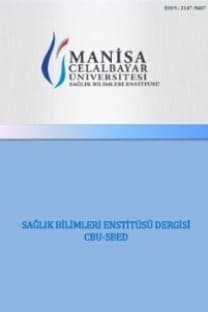Pektus Ekskavatum ve Pektus Karinatumlu Hastalarda Görülen Postür Bozuklukları
Postural Disorders in Patients with Pectus Excavatum and Pectus Carinatum
___
- 1.Prasad, S.A, Growth and development of the cardiorespiratory system, In: Prasad SA, Hussey J (ed) Pediatric Respiratory Care, 1nd edn, Chapman&Hall, Atlanta,1995. pp 1-12.
- 2.Moriggl, B, Deformities of the anterior thoracic wall; Functional anatomy of the thoracic cage, In: Schwabegger AH (ed) Congenital thoracic wall deformities: diagnosis, therapy and current developments, Springer-Verlog Wien, 2011, 3-13.
- 3.Blanco, F.C, Elliott, S.T, Sandler, A.D, Management of congenital chest wall deformities, Seminars in Plastic Surgery, 2011, 25, 107- 16.
- 4.Shamberger, R.C, Chest Wall Deformities, In: Shields TW (ed) General Thoracic Surgery, Williams&Wilkins, Baltimore/ Philadelphia, 1994, pp 529- 557.
- 5.Kuhn, M.A, Nuss, D. Pectus deformities. In: Mattei P (ed), Fundamentals of Pediatric Surgery, Springer, New York, 2011, 313- 322.
- 6.Welch, K.J, Satisfactory Surgical Correction of Pectus Excavatum Deformity in Childhood, The Journal of Thoracic Surgery, 1958, 36, 697-713.
- 7.Quigley, P.M, Haller, J.A, Jr., Jelus, K.L, Loughin, G.M, Marcus, C.L, Cardiorespiratory Function Before and After Corrective Surgery in Pectus Excavatum, Journal Pediatry, 1996, 128, 638-643.
- 8.Gürkök, S, Pektus ekskavatum deformitelerinde açık cerrahi tedavi yöntemleri, Journal of Clinical and Analytical Medicine, 2011, 60-9.
- 9.Shneerson, J.M, Rehabilitation in thoracic wall deformities, In: Donner, C.F, Ambrossino, N, Goldstein, R.S, (ed), Pulmonary rehabilitation. 1nd ed. Edward Arnold, New York, 2005, 266-277.
- 10. Kelly, R.E, Shamberger, R.C, Congenital wall deformities, In: Coran A.G, Adzick, N.S, Krummel, T.M, Laberge, J.M (ed), Pediatric Surgery, 7nd ed, Elsevier Saunders, Philadelphia, 2012, 779-808.
- 11. Roberts, J, Hayashi, A, Anderson, J.O, Martin, J.M, Maxwell, L.L, Quality of life of patients who have undergone the Nuss procedure for pectus excavatum: preliminary findings, Journal Pediatric Surgery, 2003, 38, 779—83
- 12. Morhuis, W.J, Mulder, H, Wapperom, G, et al, Pectus Excavatum, A clinical Study with Longterm Postoperative Follow-up, European Journal of Cardio-Thoracic Surgery, 1992, 6, 318-328.
- 13. Culham, E.G, Jimenez, H.A, King, C.E, Thoracic kyphosis, rib mobility, and lung volumes in normal women and women with osteoporosis, Spine, 1994, 19(11), 1250-1255.
- 14. Steinmann, C, Krille, S, Mueller, A, Weber, P, Reingruber, B, Martin, A, Pectus excavatum and pectus carinatum patients suffer from lower quality of life and impaired body image: a control group comparison of psychological characteristics prior to surgical correction, European Journal of Cardio-Thoracic Surgery, 2011, 40(5), 1138- 1145.
- 15. Croitoru, D, Nuss, D, Chest wall anomalies: pectus excavatum and pectus carinatum, Adolescent Medicine, 2014, 15, 455-471.
- 16. Nuss, D, Kuhn, M.A, Obermeyer, R.J, Our approach: MIS repair of pectus excavatum, Contemporary surgery, 2007, 63(9), 444.
- 17. Hebra, A, Minimally invasive repair of pectus excavatum, Seminars in Thoracic Cardiovascular Surgery, 2009, 21(1), 76-84.
- 18. Akkaş, Y, Peri, N.G, Koçer, B, Gülbahar, G, Aksakal, F.N.B, The prevalence of chest wall deformity in Turkish children, Turkish Journal Medical Science, 2018, 48(6),1200-1206.
- 19. Magee, D.J, Orthopedic Physical Assessment, Gait Assessment, W.B.Saunders Company, Toronto, 1997, 362-376.
- 20. Shamberger, R.C, Welch, K.J, Surgical correction of pectus carinatum, Journal Pediatric Surgery, 1987, 22(1), 48-53.
- 21. Pilegaard, H.K, Growth and pectus excavatum: is there a relation? European Journal of Cardio-Thoracic Surgery, 2016, 50(6), 1110.
- 22. Park, H.J, Sung, S.W, Park, J.K, Kim, J.J, Jeon, H.W, Wang, Y.P, How early can we repair pectus excavatum: the earlier the better? European Journal of Cardio-Thoracic Surgery, 2012, 42(4), 667- 672.
- 23. Chen, C, Zeng, Q, Li, Z, Zhang, N, Yu, J, Force required for correcting the deformity of pectus carinatum and related multivariate analysis, Journal Pediatric Surgery, 2018, 53(9), 1855-1857.
- 24. Nuss, D, Kelly, R.E, Croitoru, D.P, et al, A 10-year review of a minimally invasive technique for the correction of pectus excavatum, Journal Pediatric Surgery, 1998, 33, 545-52.
- 25. Creswick, H.A, Stacey, M.W, Kelly, R.E, Jr, et al., Family study of the inheritance of pectus excavatum, Journal Pediatric Surgery, 2006, 41, 1699-703.
- 26. Snyder, L.H, Curtis, G.M, An inherited “hollow chest”, koilosternia, a new character dependent upon a dominant autosomal gene, Journal of Heredity, 1934, 25, 445-7.
- 27. Koumbourlis, A.C, Pectus excavatum: pathophysiology and clinical characteristics, Paedıatric Respiratuar Reviews, 2009, 10(1), 3-6.
- 28. Williams, A.M, Crabbe, D.C.G, Pectus deformities of the anterior chest Wall, Paedıatric Respıratuar Reviews, 2003, 4(3), 237-242.
- 29. Saxena, A.K, Pectus excavatum, pectus carinatum and other forms of thoracic deformities, Journal of Indian Association of Pediatric Surgeons, 2005, 10(3),
- 30. Özerdemoğlu, R.A, Yorgancıgil, H, Deveci, K, Yalçınkaya, S, İlkokul öğrencilerinde ortopedik semptom ve deformite taraması, Acta Orthopaedica et Traumatologica Turcica, 1996, 30, 168-74.
- 31. Tezeren, G, Özlü, K, Aydemir, A, Ayaşlı, A, Kahraman, Y, Dülgeroğlu, D, School screening for scoliosis in Ankara, Journal of Turkish Spinal Surgery, 1993, 3, 92-94.
- 32. Frick, S.L, Scoliosis in children with anterior chest wall deformities, Chest Surgery Clinical of North American, 2000,10, 427-36.
- 33. Ekşi, M.Ş, Özcan Ekşi, E.E, Akciğer Grafisi Çektirmiş Adölesanlarda Torasik Skolyoz Taraması, Medical Bulletin of Haseki/Haseki Tip Bulteni, 2019, 57(1), 37-41
- ISSN: 2147-9607
- Yayın Aralığı: Yılda 4 Sayı
- Başlangıç: 2014
- Yayıncı: Manisa Celal Bayar Üniversitesi Sağlık Bilimleri Enstitüsü
Pektus Ekskavatum ve Pektus Karinatumlu Hastalarda Görülen Postür Bozuklukları
NURAY ALACA, İhsan ALACA, Atılay MORGÜL
Eosinofilik Granülomatoz Polyangiitis Sonrası Görülen Sitomegalovirus Enfeksiyonu - Olgu Sunumu
Kezban Armağan ALPTÜRKER, Özgül SOYSAL GÜNDÜZ, Nurullah AKKOÇ
Manyetik Kateter Yönlendirme Sistemleri
Özge AKBÜLBÜL, Mert ŞENER, Gökhan ÖZDEMİR, Aylin ŞENDEMİR, Ece BAYIR, Tuncay GÖKSEL, Haydar Soydaner KARAKUŞ, MUTLU BOZTEPE, Levent ÇETİN, Gökmen Atakan TÜRKMEN, BARIŞ OĞUZ GÜRSES, AYSUN BALTACI
Kanserin Önlenmesi ve Tedavisinde Polifenollerin Rolü
ŞENAY BURÇİN ALKAN, Neslişah RAKICIOĞLU
Kurkumin’in MCF-7 Meme Kanseri Hücreleri Üzerine GSK-3beta ve VEGF Sinyali Aracılı İnhibitör Etkisi
DİLEK ONGAN, Berna AĞIL, Gamze YURTDAŞ, Hüsnü YILMAZ, Emre ONGAN, Devrim DÖLEK
